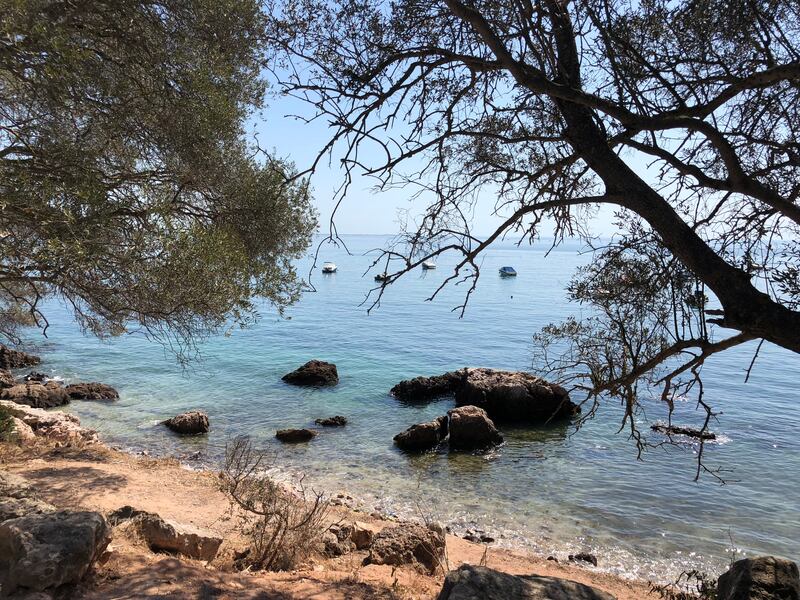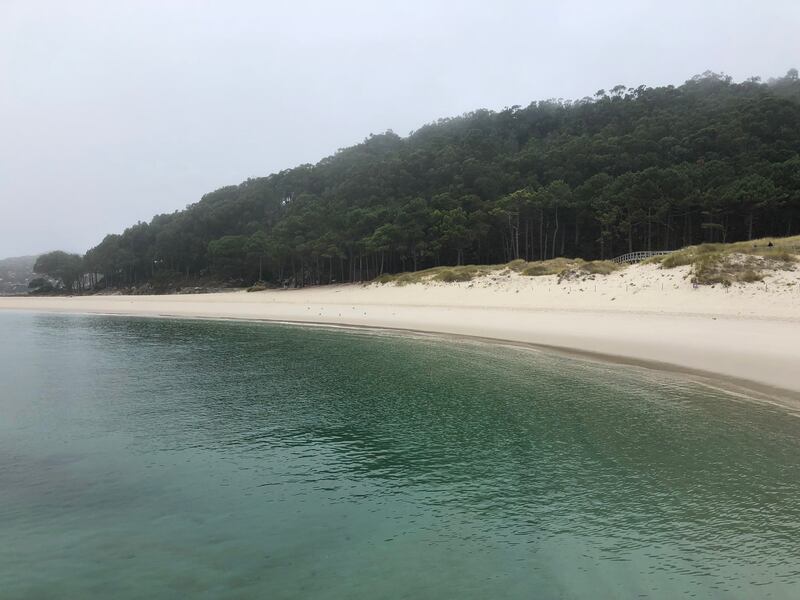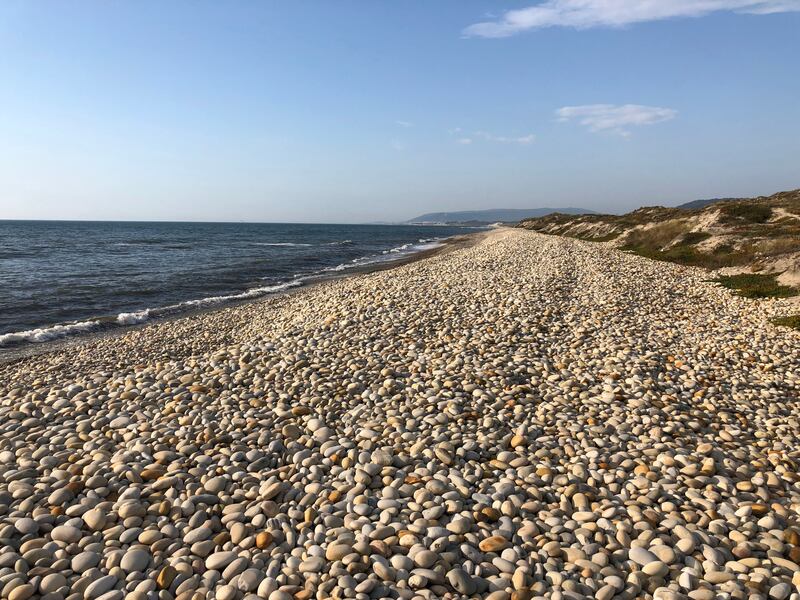I dream of beaches.
It was the middle of August, and Paris was dead—as usual at that time of year.
I had raised enough money for an omelet at L’Européen, an old-school cafe, opposite Paris’s Gare de Lyon. Voyagers with large suitcases drank coffee outside. Old ladies from the neighborhood quietly ate their lunchtime sandwiches.
After lunch, I inspected the departures board inside the station, reading the list of trains bound for the Riviera. But I was house-bound. I was cat-sitting until the herd returned to town.
(A Dutch fashion start-up had reneged on a contract, leaving me stranded for the summer. “Who gives a f++k if another freelancer doesn’t get paid,” declared the founder, who was sitting pretty in a Dutch billionaire’s pied-à-terre, living on Spanish Tortilla and red wine.)
But I dreamed of beaches. What’s more, I was supposed to be reporting on Portugal’s wildest. I had discovered a little-known pilgrimage route, the Senda Litoral, that goes directly along Portugal’s beaches. I decided to walk it to find some hidden gems, as soon as I could leave Paris.
Thankfully, Paris is on a mission to update its pools for the 2024 Olympics, so while I waited for that moment to come, I swam between the minimalist white walls and Schiaparelli pink umbrellas, offset by the deep blue water of the Olympic-sized Piscine Hermant. Think David Hockney and Los Angeles.
I had seen photographs of a well-known Portuguese beach that had been named Europe’s best. The crescent-shaped Bay of Galapinhos was surrounded by turquoise and green waters. There was a long stretch of white sand, and verdant foliage all around. Its beauty captivated me.
While it didn’t belong to the category of wild beaches, it propelled me towards Portugal. I wanted to see it. The overnight train from the French border town of Hendaye to Lisbon is inexpensive. I raised the money fast. The train from Paris to Hendaye is around five hours. The overnight train from there takes 14 hours.
A day after the herds returned, I arrived in Lisbon to find a doughnut stand on a deserted train platform. I chomped on the traditional custard filling, drinking fresh juice and tea, letting the peacefulness of Portugal soak into my bones. This was rush hour. It felt like a celebration. I had made it, against the odds.

Before I embarked on the Senda Litoral Pilgrimage Route, I decided to spend a few days relaxing at Galapinhos and other pretty beaches in the surrounding Parque Natural da Arrabida.
From my base in Setubal, an hour from Lisbon, I also explored the Troia Peninsula, reached by boat. It is home to Comporta, the windswept beach which is reportedly a summer hang out for Madonna and Christian Louboutin. It was wild and ferocious but it was known.
The Senda Litoral, is the least traveled and least known of all of the camino routes that converge upon the Spanish pilgrimage town of Santiago de Compostela. Most go through France and Spain. This one goes directly along the Portuguese coast, literally along the beach.
I had decided to follow the pilgrimage route to find some of Portugal’s lesser-known wildest beaches. Most people start this route in Porto in the north of Portugal, so I took the train there. Once there, I set out from the Se Cathedral, collecting my pilgrim’s passport en route which could be useful securing places to sleep along the way.
I wasn’t strictly a pilgrim. On the outskirts of town, just as the weight of my bags kicked in, I found Circ electric scooters. I downloaded the app and whizzed by the few pilgrims, walking religiously on the rickety wooden boardwalks that connect the empty, wild beaches that soon appeared, and pave the way north to Santiago.
“Go girl,” called a group of American pilgrims.
After miles of mostly abandoned beaches, I soon discovered the first of a series of magical beaches. Praia de Pedras do Corgo is home to colorful Noddy-style tents. It was the definition of cute.
Somewhere further on in the beach wilderness, a fellow pilgrim helped me carry my scooter up some steps, and declared it was time to swim. We were next to a picturesque cove, Praia Sampaio Castro, inhabited by a smattering of sun worshippers in the know. The waves were wild.

I spent my first night as a pilgrim at the Orbitur campsite at Povoa de Varzim, which gives pilgrims warm meals and beds. I stayed in Orbitur campsites all the way up the Portuguese coast. They were hospitable and better for discovering beaches. The next morning, most pilgrims headed inland, but I walked along the beach. Soon another of these Noddy tent enclaves appeared on a wild, ferocious beach at Apulia. A handful of people walked towards the wild water.
I stuck to the beach for 23 kilometers that day. I didn’t see any other pilgrims, just miles of wild beaches connected between new boardwalks with information boards and signs for walkers on the Senda Litoral. There were intermittent cafes. It was heaven.
A group of camper vans had staked a claim to another wild, empty beach at Esposende-Marinhas.
Further north, the sand was replaced by giant pebbles, at the deserted beach at Belinho. It was so desolate I was afraid to walk alone. The boardwalks had stopped. I took an Uber to the Orbitur campsite at Caminha on the Spanish border. I had a beach at the lake and the beautiful, coastal beach on the other side of some sand dunes to myself for two days.
A boatsman waited in the dense mist to take his sole passenger to Spain, on the other side of the lake. I was deposited in deep fog on a wild stretch of beach, surrounded by forest. I was alone. “Walk four kilometers in that direction,” he declared. I was terrified. Thankfully, I scrambled up the beach to find a dog walker and someone riding a bike. There was civilization and then, for miles, nothing but rugged coastline as I continued towards Santiago.
I spent my first night in Spain sleeping above the wild waves of the Atlantic, decked in 10 blankets provided to a pilgrim by the campsite en route. I had one more wild beach discovery ahead of me which wasn’t planned.
The Atlantic islands further north near Vigo in Spain were reportedly home to a beach, Rodas, that had been called the world’s best by a reporter for The Guardian. A long walk, a bus ride and another boat-ride later, I found myself on one of the Atlantic islands. The Cies island is a magical place, if ever there was one.
I walked through the curios swamp land behind Rodas beach and swam in the cold water and fog.
Behind it lay a small campsite that was open for the last weekend of the season. Only 1,800 visitors are allowed on the island each day. To stay or to go?
But I was out of time. I took a train to Santiago the next morning, posed in front of the cathedral, and trundled the next day across the north of Spain on a train filled with pilgrims—most of whom had walked that very route in the opposite direction, starting their pilgrimage at the French border.

I spent my last night in the pilgrim’s auberge at the French-Spanish Border Town of Irun which dutifully stamped my pilgrim’s passport acquired at the Se Cathedral in Porto, upon departure. It was my first and last pilgrim’s auberge.
At 6 a.m., I was woken up by loud religious music. I found myself running through a torrential downpour to make the first train to Paris from Hendaye, exhausted but much wiser about beaches. From Europe’s to the world’s best or even Portugal’s wildest.
Photos popped up of my fellow pilgrims posing in front of the cathedral in the coming days. But I had another message to share.
If you want to discover Portugal’s wildest beaches, simply put a pin in the map between Galapinhos and Rodas beach, and start walking north.

